 |
||
|
||
| ||
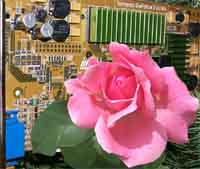 The most advanced and the fastest 3D-accelerator today can be compared with the most beautiful creation of the nature - a rose. The thorns are also here - the price is terribly "biting". We have already considered a problem of correlation of the price for video cards based on the GPU GeForce2 Ultra with their possibilities and power. Undoubtedly, today not everyone can permit himself to buy such cards, they belong to the high-end class of gaming video cards. But soon we will find on the shelves the NVIDIA NV20 based cards which will replace the current GeForce2 Ultra based card, thus moving the latter ones a step down. On the market the price for "Ultra" dropped down lower than $400, and the release price is just a bit higher than $300. A wide known company Innovision Multimedia have offered a market its new high-end product - the Inno3D Tornado GeForce2 Ultra. And today it will serve a subject of our discussion. We have already touched upon several GeForce2 Ultra based video cards; today we will discuss one more. The card which is rather beneficial since Inno3D Tornado GeForce2 Ultra is one of the cheapest video cards on the most powerful graphics accelerator of 2000. The earliest products of the firm (Riva TNT2/Savage4 etc.) have brought an ill fame to the company due to low reliability and low quality of implementation, what resulted, first of all, in a too blurry 2D-image. But production of the GPU GeForce2 GTS/MX based products helped the company to gain authority. The engineers managed to create new products combining both quite quality design, which follows the reference one from NVIDIA, and moderate prices. BoardThe board has AGP x2/x4 interface, 64 MBytes DDR SGRAM located in 8 chips on the right side of the PCB. 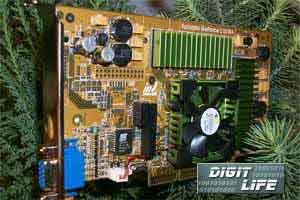 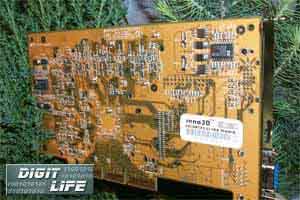 The memory chips are produced by EliteMT and are intended for 250 (500) MHz working frequency due to 4 ns access time.  In spite of it, the memory operates at the lower frequency - 230 (460) MHz. It's connected with the fact that the chips of so fast memory overheat quickly at their rated clock speed, and therefore, work unstable. That's why NVIDIA decided to decrease the working frequency of the memory and for the first time installed cooling heatsinks located on the memory modules which can be seen on the photo above. Nevertheless, the memory proved to be stable and reliable not only when at the frequencies rated for the GeForce2 Ultra, but it also managed to operate flawlessly when at the clock speed rated for these chips - 250 MHz. It's easy to see that the board completely corresponds to the reference design; it differs from an identical card from Creative only in color (our PCB is yellow). As you might know, the reference design of such cards for NVIDIA was developed exactly by Creative Labs. The graphics processor is equipped with a huge active cooler, a fan of which blows on an almost flat radiator, that's why I doubt in high efficiency of such cooling. The card is supplied with neither TV-out, nor with a connector for digital monitors (DVI). The card sells in the Retail-package:  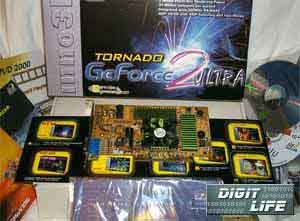 Apart from the board in the box you can find the following things:
It's nearly the richest set I have ever seen! OverclockingEach overclocker seeks for a thin verge dividing a dangerous overclocking and its own desire to get everything of the device's potential. And many are in luck thanks to the well thought out cooling approach. Note that overclocking is connected with a possibility of installation of an additional cooling device. As I have already mentioned, the boards of the GeForce2 Ultra class are equipped with a very fast 4 ns memory which is capable of operating at the rated 250 MHz, but due to some technical reasons many types of such memory can not run flawlessly at the rated clock speed. Moreover, not so long ago it was only the EliteMT modules that worked reliably at 230 MHz. Nevertheless, overclocking is possible. And according to the Leadtek WinFast GeForce2 Ultra, the overclocking may be considerable. The Inno3D Tornado GeForce2 Ultra managed to run stable at 300 MHz of the graphics core and 250 (500) MHz of the memory. The results are rather modest comparing to the previously considered analogs, but even such overclocking, first of all in terms of memory, must lead to a significant performance gain. Note that we used an additional fan installed in the case of the test machine. Installation and driversThe testbed is:
The card ships together with the drivers of 6.18 version. The tests, however, were carried out with 6.47 version drivers (VSync was disabled). For comparison, we used the performance results of the ATI RADEON 64 MBytes (Retail-package, 183/183 MHz), AOpen PA256 Deluxe, Leadtek WinFast GeForce2 Ultra and ASUS AGP-V7700 Pro. Test resultsFirst up is 2D-graphics. First of all I should let you know that with a good monitor which works not at the maximum frequency and resolution, you must not have problems in 2D with the vast majority of the GeForce2 based video cards. 2D quality of the GeForce2 based cards is just perfect. The today's sample of the Inno3D Tornado GeForce 2 Ultra has high quality level. Moreover, this card has not any artifacts in the form of horizontal ripples appearing at the definite frequencies of such cards. Before examination of this card I worked several days with the ATI RADEON (ViewSonic P817 monitor, 1600X1200X85Hz) in order to reveal the difference between these cards in 2D. So, after installation of the Inno3D Tornado GeForce 2 Ultra the 2D quality even improved a bit. The same concerns many other GeForce2 based video cards. That's why if the image is not so good as you expected, then first of all check whether your monitor corresponds to the claims you set for the graphics accelerator. Besides, there are some monitors which react differently on the different video cards. For example, many monitors from Samsung can be found guilty. I witnessed several cases when a video card provided a blurred image on one monitor and gave out a perfect image when connected to a display of another series of the manufacturer. Now comes an estimation of the card's performance in 3D. The following programs were used:
Quake3 ArenaThe test on the standard demo002 was carried out in two modes: Fast (shows card's work in 16-bit color) and High Quality (shows card's work in 32-bit color). 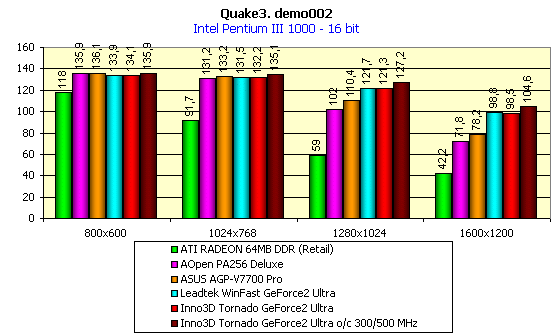 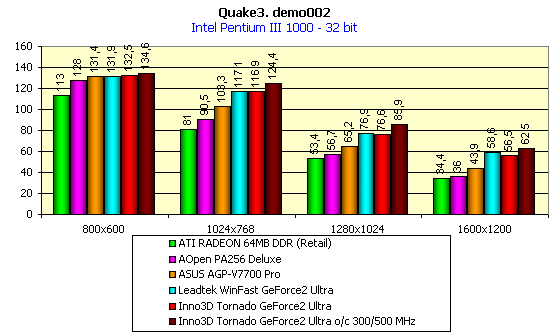 ExpendableWe will use this game to show the card's speed in Direct3D.  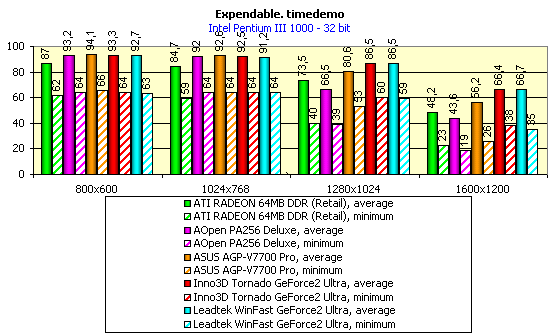 You can see that the Inno3D Tornado GeForce 2 Ultra showed the brilliant performance, on the level of the contestant Leadtek WinFast GeForce2 Ultra, having left behind many others with a considerable margin. Overclocking yields a significant performance increase. Well, the summary on the Inno3D Tornado GeForce2 Ultra's performance:
ConclusionWell, Innovision Multimedia company has introduced a high quality product which not only features parameters not worse than that of the competitors. It also has a lower price. The fact that the card's implementation strictly follows the reference design allows to be completely sure in its reliability. The speed results were considered a lot of times; just check our corresponding reviews and digest releases. Highs:
Lows:
Write a comment below. No registration needed!
|
Platform · Video · Multimedia · Mobile · Other || About us & Privacy policy · Twitter · Facebook Copyright © Byrds Research & Publishing, Ltd., 1997–2011. All rights reserved. |